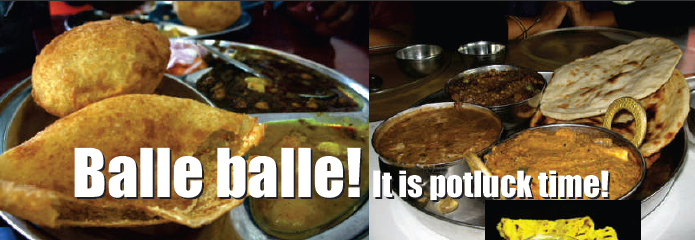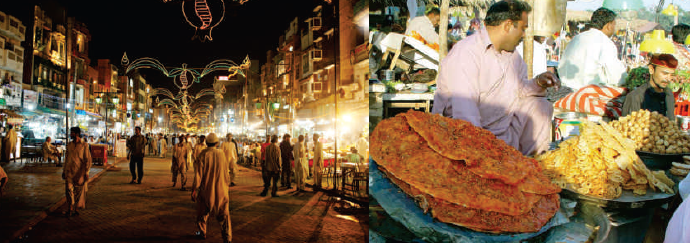Amritsar
(Created page with " {| class="wikitable" |- |colspan="0"|<div style="font-size:100%"> This is a collection of articles archived for the excellence of their content.<br/>You can help by convertin...") |
(→Amritsar) |
||
| Line 20: | Line 20: | ||
By GUNVANTHI BALARAM | By GUNVANTHI BALARAM | ||
| − | India Harmony Volume - 1 : Issue - 2, 2013 | + | '' India Harmony Volume '' - 1 : Issue - 2, 2013 |
[[File: AMRITSAR.png||frame|500px]] | [[File: AMRITSAR.png||frame|500px]] | ||
Revision as of 19:09, 11 January 2014
This is a collection of articles archived for the excellence of their content. Readers will be able to edit existing articles and post new articles directly |
Amritsar
The Dhabas of Amritsar
By GUNVANTHI BALARAM
India Harmony Volume - 1 : Issue - 2, 2013
After a kulcha, crunchy with oodles of butter on the outside, attack the gulab jamun instead. Then, try a kebab. In the holy city of Amritsar, nobody can go hungry. For pilgrims and the poor, there's the divine langar at the Golden Temple. For tourists and the locals, as well, there's the ubiquitous dhaba - that hole-in-the-wall eatery that dishes up the most flavoursome and fragrant of food at the humblest of prices. They are Amritsar's USP - "unique selling proposition" - they have a wide-ranging clientele, from ministers to rickshaw-wallahs. Let not its dingy climes lead you astray: the dhaba is the best place to eat at in Amritsar. The food is not just hot and tasty, it's invariably also fresh and clean. Now we know why the Amritsaris quite often prefer to send out for food rather than cook in their own kitchens. The "Amritsari kulcha" is worth devouring, certainly - it's this plump, yet just that flaky maida roti, soft with potato and onion spiced with pepper, chilly, jeera and anardana on the inside and crunchy with oodles of butter on the outside. Eaten only at breakfast or brunch, it is served with gravied chole (the small chana) and a chutney of tamarind, jaggery and onion, or of tamarind, mint, onion and green chilly.
It's a kulcha that cannot be found anywhere else in the Punjab, not even some miles down the road in Ludhiana. I didn't know any better, but Kiranjot Kaur, the young ex-secretary of the Shiromani Gurdwara Prabhandak Committee (who, along with conservationist Gurmeet Kaur Rai, has initiated measures to have the Golden Temple listed as a World Heritage Site), informed me that the best breakfast places are "All India Fames" (lately corrected to Famous, alas) "Kulcha-Chola Dhaba" on Maqbool Road, "Kanha's" on Lawrence Road and "Kanahya's" at Phullonwala Chowk. "Don't go away without trying the poori-alu and gur-halwa, it's our traditional Sunday brunch", Kiranjot said emphatically, after I had interviewed her about more material matters at the Golden Temple. I wasn't about to disobey her. At Kanahya's, the pooris (of wheat) were light and fluffy; the potatoes, in a sauce of jaggery and tamarind, tangy. The famous kulcha-chole, dished up by the brothers Dalbir and Samarjit Singh for ten rupees, also lived up to its reputation.
Nitasha had also instructed me to eat everything I possibly could in the pilgrim town. "Not just Amritsari kulcha and Amritsari fish, but also pakoris, kachauris, jalebis, phirni, kulfi,ma-ki-dal, the prasad at the Harmandir Sahib, the works". Playing glutton was easy.
I munched on kachauris on the thirty-minute ride to the Wagah border. Crisp and spicy. The patriotic slogans were still ringing in my ears when I returned for the stuffed parathasand the ma-ki-dal at the "1917 Bharawan da Dhaba" near the Town Hall.
The mooli paratha is guaranteed to satisfy, but the dal is too buttery. I sampled more of the same at a pokey little shop in Jalianwala Bagh. That was better: more spicy, less buttery. And cheap, at Rs. 5 a bowl. Skipping its famous thali, I sampled the mithai at the "1916 Kesar da Dhaba", tucked away in the intestine of an old bazaar. The rasmala - marble-sized golis in mellow malai - andgajjar da halwa were divine. So was the phirni - silvery and feather light on the tongue. I saw a Sardar from the diaspora (accent loud and clear) cheerfully having helpings of all three. In Amritsar, there's manna from the halwaii. The town, like Calcutta, has a mithai shop every hundred meters. And ajalebiwala inbetween. The Amritsaris' lust for jalebis has to be seen to be believed. They munch on them from dawn to midnight - at the 90-year-old "Gurudas Ram Jalebiwala" in the Katra Ahluwalia area, for sure. If they feel like a change, they attack the gulab jamuns instead. I was high enough on the rasmalai and phirni, so I opted to save the jalebi-and-jamun trip for another time.
All too soon, it was time to take the train back to Delhi. On the way to the station, I stopped to buy papads and Amritsar di Pinni for my friends. Laden with parcels, I sat back in the cycle-rickshaw, a tad wistful that it was all over. But as the old rickshaw-wala struggled up a hillslope, I saw this little kulfishop, the name of which I cannot recollect.
I asked him to stop, went in and grabbed two plates of - what else - malai kulfi. We ate it sitting out in the creaky rickshaw. Creamy yet textured, quite like the land, it was wonderful!

